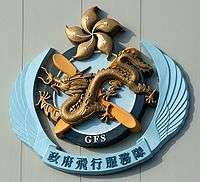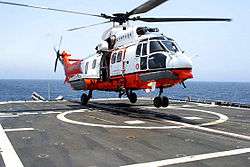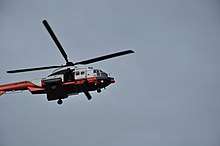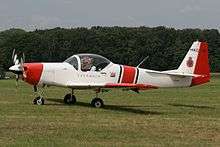Government Flying Service
The Government Flying Service (GFS) is a disciplined unit of the Government of Hong Kong. It was established on 1 April 1993, when Hong Kong was under British rule.[2] It then took over all the non-military operations of the Royal Hong Kong Auxiliary Air Force (RHKAAF), which was an auxiliary unit of the United Kingdom Royal Air Force. After Hong Kong was handed over to the People's Republic of China in 1997, the GFS remains as a government unit of the Hong Kong Special Administrative Region, and is responsible for search and rescue (SAR), air ambulance, firefighting, and police operations.
 | |
| Agency overview | |
|---|---|
| Formed | 1993 |
| Preceding agency |
|
| Jurisdiction | |
| Headquarters | Hong Kong International Airport |
| Employees | 225 |
| Annual budget | HKD 577.6 million (2016-17)[1] |
| Minister responsible | |
| Agency executive |
|
| Parent department | Security Bureau |
| Website | www |
| Government Flying Service | |||||||||||||
|---|---|---|---|---|---|---|---|---|---|---|---|---|---|
| Traditional Chinese | 政府飛行服務隊 | ||||||||||||
| Simplified Chinese | 政府飞行服务队 | ||||||||||||
| |||||||||||||
 |
|
Politics and government of Hong Kong |
|
|
|
Legislature |
|
Court of Final Appeal
Special courts and tribunals: |
|
|
Related topics |
- For the Slovak state carrier, see Slovak Government Flying Service.
The service operates from the southwestern end of Hong Kong International Airport at Chek Lap Kok. Before the opening of the Chek Lap Kok airport in 1998, it operated from the old Kai Tak Airport (i.e. the former Hong Kong International Airport). GFS patrols a 400-nautical-mile (740 km) radius of Hong Kong's Maritime Search and Rescue Region, as well as the Hong Kong Flight Information Region, which covers most of the South China Sea basin.
In 2007, the former dispersal in the old Kai Tak Airport was re-opened as a sub-base, providing refuelling and other supporting services for GFS's helicopters. The helipad is located near the foot of Cheung Yip Street.
Operations

GFS is broken down to operational sections:
- Operations Section – day-to-day core functions (i.e. Search and Rescue)
- Training and Standards Section – professional standards and development
- Engineering Section – maintenance of GFS aircraft and equipment
- Quality Section – compliance to operational standards
- Administration Section – administration, human resources, finance, supplies, etc...
Helicopters can land on 5 highways in Hong Kong to attend to road related recovery operations. For long-range search and rescue operations, the GFS initially uses fixed wing aircraft which then guides helicopters to the location.[2]
- Air ambulance service response time (type A+/A) – 20 minutes (within island zone) / 30 minutes (outside island zone)
- Search and rescue callout time 0700-2159 -(within 50 nm/92.5 km of GFS HQ) – 1hr / 1hr 40m (with additional/specialized equipment)
- Search and rescue callout time 2200-0659 -(within 50 nm/92.5 km of GFS HQ) – 2hr
- For SARs outside 50 nm / 92.5 km – add 30mins per 50 nm
- Fixed Winged Aircraft 0700-2159 – (within 50 nm/92.5 km of GFS)- 50m, (between 50 nm/92.5 km to 100 nm/185 km of GFS)- 1hr 5m, (beyond 100 nm/185 km of GFS)- add 15m per 50 nm.
Fleet
.jpg)


The fleet currently comprises:
| Builder | Model | Mission | Number | Dates | Details |
|---|---|---|---|---|---|
| Eurocopter | AS 332L2 Super Puma | inshore/offshore search and rescue helicopter (medium lift utility helicopter); aerial fire fighting apparatus | 3 * B-HRL *B-HRM |
2002–2020 | Replaced the Sikorsky S-70A Black Hawk (return to US following retirement).
Only B-HRN is painted in white and safety orange, while B-HRM and B-HRL are pained in grey Replaced by Airbus Helicopters H175 in 2020. |
| Eurocopter | EC 155 B1 | aeromedical services, inshore search and rescue, VIP and government personnel transfer (medium utility transport helicopter) | 4
*B-HRU |
2002– | A fifth one, B-HRX, crashed at Pak Kung Au during a mission in 2003.
All painted in grey (night black and sea grey ) To be replaced by Airbus Helicopters H175 beginning in 2018. |
| Moravan | ZLIN Z242L | fixed wing trainer | 1 * B-HRA | 2009 | succeeded the role of the Slingsby Aviation T-67M-200 Firefly |
| Bombardier Aerospace | Challenger 605 | search and rescue/maritime surveillance aircraft | 2 * B-LVA * B-LVB | 2012-
2015- |
Replaced the Jetstream 41 |
| Airbus Helicopters |
H175 | Search and Rescue, emergency medical services, observation, firefighting, and law enforcement helicopter.[3] | 7
*B-LVD *B-LVE *B-LVF *B-LVG *B-LVH *B-LVI *B-LVJ |
2018 | Launch customer for the public services version with an order for 7 in 2015. All to be delivered by the end of 2018. Will replace AS332 L2 and EC155 in service.[4] |
Paint scheme for Jetstream and Super Puma is white and Safety orange, two grey (night black and sea grey) tones for the EC 155 and some of the Super Puma to support police operations (tactical troops transport). The H175s have an overall grey livery with a light grey stripe on the tile broom.
Prior to 2002, the fleet colours consisted of:
- white and Safety orange
- blue, white and red – mostly the S-76 and were the colours of the RHKAAF and similar to the scheme used by the Her Majesty's Coastguard
- night black and sea grey – mostly the S-70A
Retired fleet
The fleet has previously included:
| Builder | Model | Mission | Number | Dates | Details |
|---|---|---|---|---|---|
| Beechcraft | Super King Air | maritime surveillance aircraft; VIP aircraft (converted turboprop airliner) | 2 | 1993–1999 | from RHKAAF; replaced by BAe Jetstream 41 |
| Sikorsky Aircraft | S-70A Black Hawk | medium lift utility helicopters | 3 * B-HZJ * B-HZI * B-HZK | 1993–2002 | from RHKAAF; used for search and rescue and by the Hong Kong Police Force; replaced by Super Puma AS332 L2; S-70 sold back to the United States |
| Sikorsky Aircraft | S-76 Spirit | medium utility helicopter | 6 | 1993–2002 | from RHKAAF; used by the Government of Hong Kong and VIP service; replaced by EC 155 B1 |
| Slingsby Aviation | T-67M-200 Firefly | fixed wing trainer | 4 | 1993–1996 | from RHKAAF; replaced by ZLIN Z242L |
| British Aerospace |
Jetstream 41 | search and rescue/maritime surveillance aircraft (converted turboprop regional airliner) | 2 * B-HRS * B-HRT |
1999- 2016 | Replaced by Bombardier Challenger 605
B-HRS being preserved in Kai Tak Runway Park permanently |
Equipment and Gear
Standard equipment for GFS personnel is:
- Flight suit or jumpsuit
- Special Operations Vests (SOVs) – consists of a small oxygen tank (3 minutes of oxygen), life jacket, small survival/first aid kit.
- Helicopter helmet
- Walkie-talkie
- gloves
As the GFS is not a police or para-military unit, they are unarmed. Armed officers of the Hong Kong Police Force fly with the GFS on occasion.
Personnel
GFS employs 238 personnel:
- 178 commissioned/disciplined personnel
- 60 civilian personnel
Most of the pilots in the GFS were localised prior to the handover in 1997, as former RAF and other British military personnel departed Hong Kong.
The GFS is led by a controller, who reports to the Secretary for Security. The current controller is Captain Michael CP Chan.
Other senior officers of the GFS are:
- Departmental Secretary
- Chief Pilot (Operations)
- Chief Pilot (Training and Standards)
- Chief Aircraft Engineer
- Flight Operations Manager
- Manager (Quality Assurance)
- Manager (Quality & Flight Safety)
- Manager (Aircrewman Officer)
Uniform
Operations uniforms:
- green Jumpsuit or separate Flight jacket and pants - pilot and aircrew [5][6]
- blue jumpsuit or separate Flight jacket and pants - mechanics and engineers[7][8]
Dress uniforms:[9]
- light blue shirt (short sleeve for summer and long sleeve for winter) with dark tie dress jacket and pants
- dark skirts for women
- sweaters for men
- dark windbreaker jacket for summer
- Peaked cap - male and female variations
Rank
Prior to the creation of the GFS, the ranks within the Royal Hong Kong Auxiliary Air Force were the same as the RAF. The late 1980s and early 1990s saw the transition to local staff in the RHKAAF in preparation for the civil transfer to the GFS role. For details and insignia of the ranking, see http://www.gfs.gov.hk/eng/insignia.htm
Ranking of personnel of the GFS are civilian aviation roles and are as follows:
- 1 Bauhinia and 1 Laurel Wreath with Crossed Feather
- 1 Bauhinia and 2 Pips
- Chief Pilot
- Chief Aircraft Engineer
- 1 Bauhinia and 1 Pip
- Senior Pilot
- Senior Aircraft Engineer
- Senior Aircrewman Officer
- 1 Bauhinia
- Pilot I
- Aircraft Engineer
- Aircrewman Officer I
- 3 Pips
- Pilot I
- Aircraft Engineer
- Aircrewman Officer I
- 2 Pips and 1 Bar
- Pilot II
- Aircraft Engineer
- Aircrewman Officer II
- Chief Aircraft Technician
- 2 Pips
- Pilot II
- Chief Aircraft Technician
- Senior Aircraft Technician
- Aircrewman Officer III
- 1 Pip
- Cadet Pilot
- Senior Aircraft Technician
- Aircraft Technician
- Aircrewman Officer III
Pilot II and Cadet Pilot ranks were created in the 1990s for local pilots with less flying experience.
Controllers
List of past controllers of the GFS:
- Captain Brian Cluer - former RAF fighter pilot and General Manager of Operations, Cathay Pacific
- Captain Brian Butt Yiu-ming - formerly with Royal Hong Kong Auxiliary Air Force and Chief Inspector with Hong Kong Police specializing in the counterfeit detection[10]
Crest
The current crest of the force was adopted in 1997, prior to which the Hong Kong Coat of Arms was used on GFS aircraft:
- Bauhinia
- Crest with a Chinese dragon, propeller (borrowed from the Royal Hong Kong Auxiliary Air Force crest) and wording GFS
- Motto contain the wording "政府飛行服務隊" with a pair of wings provides a bilingual logo to the agency that was lacking in the previous agency
GFS in the media
- The service's official theme song, Wishing You Well So Much (多想你好), was sung by Andy Lau.
- The TVB drama "Always Ready" was filmed inside GFS HQ and starred Ekin Cheng.
Incidents
- 26 August 2003 – A Eurocopter EC 155 B1 crashed on a hill at Pak Kung Au near Tung Chung on Lantau Island killing two aircrew (Pilot Pang Fu-kwok and Airman Chan Man-tik).
- 27 December 2010 – One of the GFS's Eurocopter Super Puma Mk II helicopters (B-HRN) ditched in Shing Mun Reservoir after the loss of its number 2 engine. It was in the process of collecting water from the reservoir to drop on a hill fire. None of the three crew members were injured. The Civil Aviation Department said on the following day it had retrieved the flight data recorder. Pending a final report, an interim bulletin issued in February 2012 reported that the number two engine was correctly shut down automatically by the engine control unit because the turbine had begun to overspeed, because there appear to be no fault in the turbine or the fuel systems the overspeed is possibly the result of a disconnection of the engine from the main gearbox because of wear to the freewheel unit that connect the two.[11] The Helicopter was rebuilt by the engineering team after it was recovered from the reservoir.
See also
References
- Government Budget Head 166
- "Government Flying Service." Information Services Department. Government Flying Service. March 2016. Retrieved 2017-06-05.
- "ANALYSIS: H175 SAR delivery offers lift to programme". Flightglobal.com. 20 June 2018. Retrieved 21 June 2018.
- "Hong Kong's Government Flying Service receive first H175s in public services configuration". Airbus. Retrieved 21 June 2018.
- "Pilot Grade." Government Flying Service. Retrieved 2017-06-05.
- "Air Crewman Officer Grade." Government Flying Service. Retrieved 2017-06-05.
- "Aircraft Engineer Grade." Government Flying Service. Retrieved 2017-06-05.
- "Aircraft Technician Grade." Government Flying Service. Retrieved 2017-06-05.
- "Uniform." Government Flying Service. Retrieved 2017-06-05.
- http://www.scmp.com/article/631233/happy-landings
- "Accident bulletin 1/2012." Chief Inspector of Accidents. Accident Investigation Division. 9 February 2012. Retrieved 2017-06-05.
External links
| Wikimedia Commons has media related to Hong Kong Government Flying Service. |
